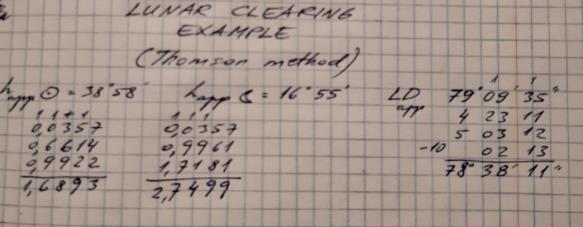
NavList:
A Community Devoted to the Preservation and Practice of Celestial Navigation and Other Methods of Traditional Wayfinding
From: Modris Fersters
Date: 2022 Sep 2, 11:54 -0700
Hi, Edward Falk!
You wrote: “Without a calculator, it's hella complicated. I've been reading the 1902 edition of Bowditch lately. The corrections include referencing 13 different tables. With a calculator, it's not so bad.”
You are absolutely wrong about complexity of lunar calculations “in paper format”. You studied 1902 edition of Bowditch. This edition contains Chauvenet method of clearing lunars. This method is very accurate, but was seldom practised, because it was invented after lunars were popular at sea (and I also think— because this method is realy quite odd and complicated).
In 1902 lunars were not practised (maybe only by some fanatical navigators for chronometer check). If you are interested in real lunar calculations that were practised at sea, you should look in logbooks and navigation books from first decades of 19 century.
Clearing lunars, for example, with Thomson method takes for me about 6 minutes (Thomson’s method was included in Bowditch in 1837, if I remember correctly). And this can be done only with paper, pencil and basic arithmetic operations (addition and substraction). No math genius is needed. Of course, the whole process to get longitude is longer (including preperation for clearing, time sight calculations etc.). But usually in different articles clearing of lunars is emphasized as the most difficult.
I will add page with lunar clearing example to show how little mathematic operations are needed to clear lunars without calculator. And you will need only 5 tables (not 13 as you mentioned).
Of course, there are some methods that are more complicated, but the main idea I would like to emphasize: clearing lunars is easy for everyone who can perfom addition and substraction operations. It is a myth that lunars were the most complicated aspect of navigation. It was complicated for astronomers and mathematicians who had to predict Moon’s position at sky and invent methods useful at sea. They made tables, developed methods and different algorithms etc, but navigators could do easy arithemthic operations.
Modris Fersters







